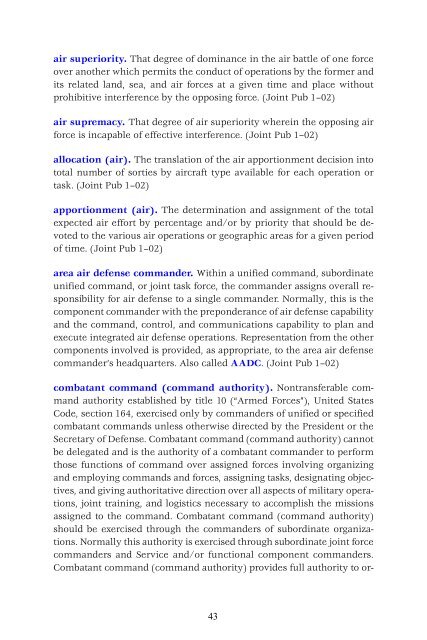Air Force Doctrine Document 2-1.1
Air Force Doctrine Document 2-1.1
Air Force Doctrine Document 2-1.1
You also want an ePaper? Increase the reach of your titles
YUMPU automatically turns print PDFs into web optimized ePapers that Google loves.
air superiority. That degree of dominance in the air battle of one force<br />
over another which permits the conduct of operations by the former and<br />
its related land, sea, and air forces at a given time and place without<br />
prohibitive interference by the opposing force. (Joint Pub 1–02)<br />
air supremacy. That degree of air superiority wherein the opposing air<br />
force is incapable of effective interference. (Joint Pub 1–02)<br />
allocation (air). The translation of the air apportionment decision into<br />
total number of sorties by aircraft type available for each operation or<br />
task. (Joint Pub 1–02)<br />
apportionment (air). The determination and assignment of the total<br />
expected air effort by percentage and/or by priority that should be devoted<br />
to the various air operations or geographic areas for a given period<br />
of time. (Joint Pub 1–02)<br />
area air defense commander. Within a unified command, subordinate<br />
unified command, or joint task force, the commander assigns overall responsibility<br />
for air defense to a single commander. Normally, this is the<br />
component commander with the preponderance of air defense capability<br />
and the command, control, and communications capability to plan and<br />
execute integrated air defense operations. Representation from the other<br />
components involved is provided, as appropriate, to the area air defense<br />
commander’s headquarters. Also called AADC. (Joint Pub 1–02)<br />
combatant command (command authority). Nontransferable command<br />
authority established by title 10 (“Armed <strong>Force</strong>s”), United States<br />
Code, section 164, exercised only by commanders of unified or specified<br />
combatant commands unless otherwise directed by the President or the<br />
Secretary of Defense. Combatant command (command authority) cannot<br />
be delegated and is the authority of a combatant commander to perform<br />
those functions of command over assigned forces involving organizing<br />
and employing commands and forces, assigning tasks, designating objectives,<br />
and giving authoritative direction over all aspects of military operations,<br />
joint training, and logistics necessary to accomplish the missions<br />
assigned to the command. Combatant command (command authority)<br />
should be exercised through the commanders of subordinate organizations.<br />
Normally this authority is exercised through subordinate joint force<br />
commanders and Service and/or functional component commanders.<br />
Combatant command (command authority) provides full authority to or-<br />
43
















